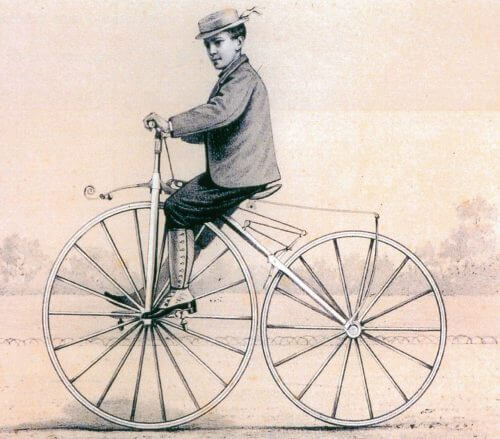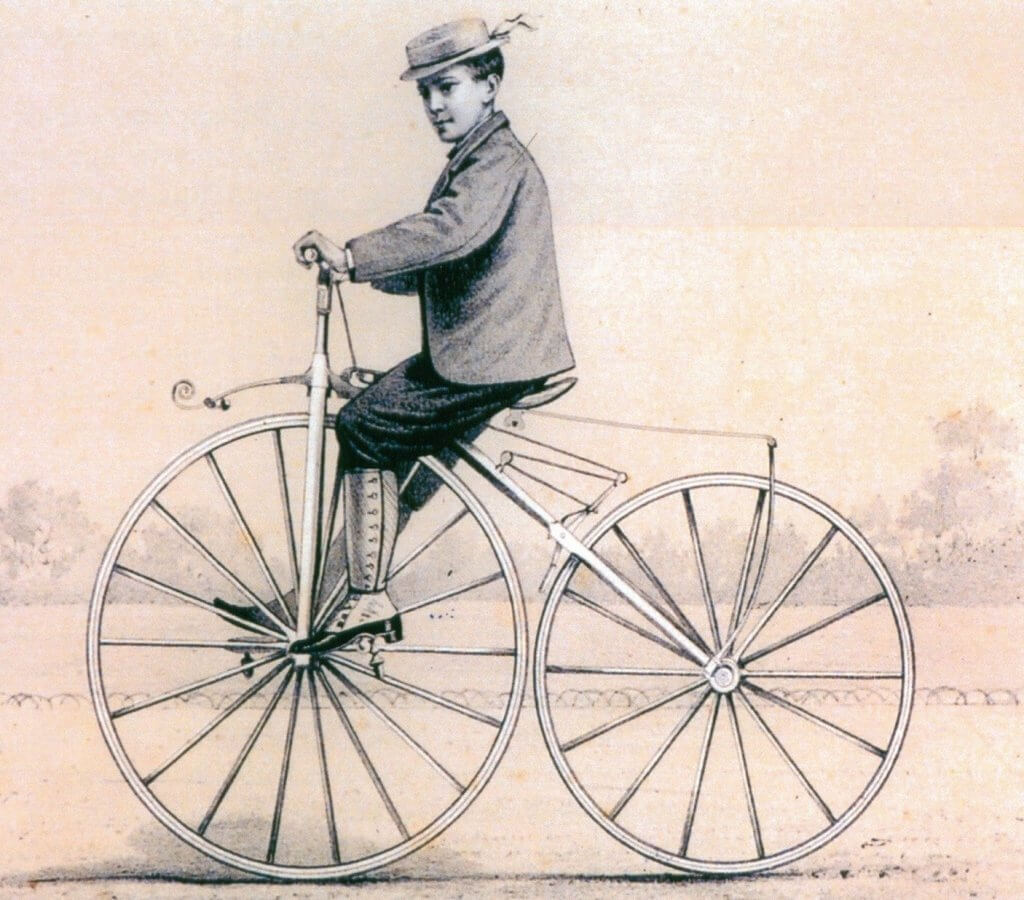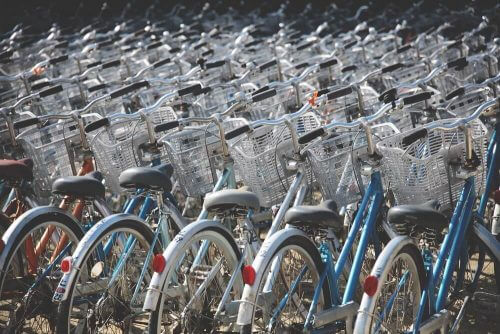What is the connection between the birth of the bicycle and the eruption of a volcano in Indonesia? Why do the young Chinese no longer want to ride two wheels? And are the electric bicycles a solution to the transportation problems in Israel, or rather a new problem? The bicycle celebrates 200 years of pedaling

By Amalia Jacobi, Angle, Science and Environment News Agency
Mazel Tov! This year the bicycle celebrates 200 years of pedaling, punctures and a pleasant wind on the face while riding. On the occasion of the round date, Prof. Ido Bruno of "Bezalel", an industrial designer and an avid cyclist, curated an interactive exhibition called "2x200 bike", which is on display at the Bloomfield Museum of Science in Jerusalem and reviews the relationship between man and wheels throughout the last two centuries. "In 1815, a volcano erupted in Indonesia and a large cloud of ash covered the earth, particularly affecting Northwest Europe," says Bruno, who curated the exhibition together with Dr. Amir Ben Shalom, about the drama that preceded the birth of the ultimate two-wheeled vehicle. "The year after that, 1816, was particularly cold and dark and was known as 'The year without summer'. The long winter of that year is responsible for all kinds of interesting cultural phenomena, for example a boom in horror literature. Mary Shelley's Frankenstein, for example, was written that year. Another result was a serious failure of agricultural crops, which led to the death of horses: firstly because there was nothing to feed them, and secondly because people were so hungry that they ate the horses."
"A year after all this, a German baron named von Dries applied for a patent for the first bicycle," adds Bruno. "It is common to say that his invention was a transportation solution to the death of the horses, but it is more likely that he started dealing with the matter a long time before, and the crisis only created a business opportunity for him."
Von Dries' bicycle had no pedals and no chain. They mainly mentioned the exercise bikes that are bought today for small children, but to make it easier to carry the weight on the pelvis they also included a front cushion, on which the rider would lean with his stomach and chest, which made the whole thing quite ridiculous. "Bicycles similar to the ones we know today - with pedals, handlebars and a chain - were born only in the 70s," explains Bruno. "But on those bikes, the pedals were attached to the front wheel. This created a speed limit, because at high speeds it was impossible to keep your feet on them. In addition, it should be remembered that at that time people traveled on dirt roads that were adapted for horses. The result was that riding a bicycle was a very painful experience, and they were even nicknamed 'the bone shakers'. As a solution to both of these problems, the bike with the huge front wheel was born, the one that was mistakenly fixed in the collective imagination as the first bike. The large front wheel did solve the problem of speed and to some extent the problem of potholes, but it made the bike dangerous and prone to overturns. In the 19's and 70's of the 80th century, the solution to the problem was found in the form of what was then called a 'safety bicycle', a model very similar to the city bicycle of today. At the end of the same century, the air-filled tire was also invented, which was attached to the bicycle and turned it into a pleasant vehicle to ride at once. It was a dramatic jump in comfort, which changed the riding experience from the edge."
Cheaper than a horse

"The bicycle was and still is an extraordinary solution, which created a great freedom of movement. Owning a horse is an expensive thing, but almost anyone can own a bicycle, so this is a significant improvement in the living conditions of the lower classes," says Bruno. "At the same time, in the last two decades of the 19th century, the suffragist movement for the liberation of women began to gain momentum. Suffragists embraced the bicycle as the ultimate expression of women's rights, despite major establishment opposition, which included doctors who argued that women who rode bicycles would be unable to give birth. As part of the interest, a bicycle suitable for female wear was born, with a low 'level' and a mesh on the rear wheel, but female fashion also changed. Following the riders, the first pants for women were created and the restrictive corsets were also loosened a bit. So the bicycle created a double freedom of movement for women: the ability to get from place to place on their own and also clothes that are more comfortable to move in. By the way, to this day there are many women's protests involving bicycles in Muslim countries, and they also touch on the need to move in the public space and the difficulty of riding a bicycle in traditional clothing."
The electric culture revolution
If at the beginning of their journey the bicycle was a tool that provided freedom of movement for the masses, then in the last decades of the twentieth century a new purpose was discovered for them: the earth in general and the cities in particular became denser, and the environmental burden of transporting the masses of people from one place to another became heavier. Once again the bicycle appeared as a solution, this time to the problems of heavy air pollution and severe traffic jams.
"In this context it is interesting to talk about the Chinese case", says Bruno. "In the past, Mao Zedong declared the bicycle as the ultimate Chinese means of transportation, and at the end of the seventies about 60 percent of the transportation there was carried out by bicycle. But as we know, China has undergone accelerated development that has resulted in the transition of huge amounts of people from the countryside to the city and huge volumes of use of motorized vehicles. This is how terrible cities were created, very polluted and very congested, but the younger generation resisted the use of bicycles. It was the symbol of the previous generation and of severe poverty, and their use was diminishing. The Chinese government declared bicycles as a national target and together with some entrepreneurs, bicycles were designed with a very different appearance from the traditional bicycles, which made it easier for young people to use them. In recent years, they have also started investing there in the field of cooperative bicycles and these have become a crazy hit. Today there are more shared bicycles in China than in the entire Western world combined."
Although in the exhibition at the Science Museum it was decided not to refer to electric bicycles, it is impossible to ignore this significant development in the subject of mass transportation. "I personally tend to consider electric bicycles more than a motorcycle with an electric motor," says Bruno, "but even if they do not exactly meet the definition of a bicycle, there is no doubt that they are leading a tremendous revolution, with a very positive potential for clean transportation and movement in the city. This revolution is still in its infancy and many problems arise from this, but after we overcome these childhood diseases, they can become a fantastic solution."
"Since the electric bikes came here, the number of riders has only been increasing," agrees Yotam Avizohar, director of the association "Israel for the bicycle". "Unfortunately, the only city in Israel that monitors the number of riders is Tel Aviv. Everywhere else we can only rely on estimates related to bike sales data. According to the CBS data, there are over 200 electric bicycle riders in Israel, and we assume that most of those who buy electric bicycles actually use them to travel in the city. This is in contrast to ordinary bicycles, which are often used for recreational riding as well."

30 million unrealized
Avizohar says that despite the growing number of cyclists, the authorities in Israel do not provide a sufficient infrastructural response to the great demand for suitable cycling conditions. "The plans actually exist," he says, "the Ministry of Transportation's 'bicycle freeway' project, which we are partners in, aims to create a network of high-standard bicycle paths that will lead to Tel Aviv from the neighboring cities. It is a great plan, but it exists only on paper, and it is neither realized nor promoted. Moreover, following our meeting with the Minister of Transportation Israel Katz, the ministry allocated a budget of NIS 50 million for bicycle paths in the local authorities. But the authorities do not use the budget. Last year, for example, only NIS 20 million of it was realized."
Lack of budget is only one obstacle on the way to a more successful integration of electric bicycles in the transportation system in Israel. "The bigger obstacle is the need to redistribute the right of way, to consider cyclists and to give up transportation routes and parking lots. The authorities do not have the necessary courage," says Avizohar. "The legislator is also not doing enough to promote awareness that can contribute to the safety of cyclists, who in the absence of paths are supposed to ride on the road. Surveys conducted by the Tel Aviv Municipality revealed that many drivers do not even know that the legal place of bicycles is on the road, and this lack of awareness creates accidents. Our bill to oblige drivers to keep a minimum distance of one meter from cyclists did not pass either. Instead, the main discourse is about cyclists as 'bad guys', who hurt pedestrians on the sidewalk. We also believe that there is no place for bicycles on the sidewalks, but we must find other solutions for them."
More of the topic in Hayadan:

One response
Good luck 🙂